Stewart J. Calculus
Подождите немного. Документ загружается.


782
|| ||
CHAPTER 12 INFINITE SEQUENCES AND SERIES
17. , 18. ,
19. , 20. ,
21. Prove that the series obtained in Exercise 7 represents
for all .
22. Prove that the series obtained in Exercise 18 represents
for all .
23. Prove that the series obtained in Exercise 11 represents
for all .
24. Prove that the series obtained in Exercise 12 represents
for all .
25–28 Use the binomial series to expand the function as a power
series. State the radius of convergence.
25. 26.
28.
29–38 Use a Maclaurin series in Table 1 to obtain the Maclaurin
series for the given function.
29. 30.
31. 32.
34.
36.
37.
Hint: Use
38.
;
39 – 42 Find the Maclaurin series of (by any method) and its
radius of convergence. Graph and its first few Taylor polynomials
on the same screen. What do you notice about the relationship
between these polynomials and ?
40.
41. 42.
43. Use the Maclaurin series for to calculate correct to five
decimal places.
e
#0.2
e
x
f &x' ! ln&1 ! x
2
'f &x' ! xe
#x
f &x' ! e
#x
2
! cos xf &x' ! cos&x
2
'
39.
f
f
f
f &x' !
+
1
6
x # sin x
x
3
if x " 0
if x ! 0
sin
2
x !
1
2
&1 # cos 2x'.
][
f &x' ! sin
2
x
f &x' !
x
2
s
2 ! x
f &x' !
x
s
4 ! x
2
35.
f &x' ! x
2
tan
#1
&x
3
'f &x' ! x cos
(
1
2
x
2
)
33.
f &x' ! e
x
! 2e
#x
f &x' ! e
x
! e
2x
f &x' ! cos&
'
x,2'f &x' ! sin
'
x
&1 # x'
2,3
1
&2 ! x'
3
27.
1
&1 ! x'
4
s
1 ! x
x
cosh x
x
sinh x
x
sin x
x
sin
'
x
a ! 1f &x' ! x
#2
a ! 9f &x' ! 1,
s
x
a !
'
,2f &x' ! sin xa !
'
f &x' ! cos x
1. If for all , write a formula for .
2. The graph of is shown.
(a) Explain why the series
is not the Taylor series of centered at 1.
(b) Explain why the series
is not the Taylor series of centered at 2.
3. If for find the Maclaurin
series for and its radius of convergence.
4. Find the Taylor series for centered at 4 if
What is the radius of convergence of the Taylor series?
5–12 Find the Maclaurin series for using the definition
of a Maclaurin series. [Assume that has a power series expan-
sion. Do not show that .] Also find the associated radius
of convergence.
6.
7. 8.
9. 10.
11. 12.
13–20 Find the Taylor series for centered at the given value
of . [Assume that has a power series expansion. Do not show
that .]
13. ,
14. ,
,
16. , a ! #3f &x' ! 1,xa ! 3f &x' ! e
x
15.
a ! #2f &x' ! x # x
3
a ! 1f &x' ! x
4
# 3x
2
! 1
R
n
&x' l 0
fa
f &x'
f &x' ! cosh xf &x' ! sinh x
f &x' ! xe
x
f &x' ! e
5x
f &x' ! cos 3xf &x' ! sin
'
x
f &x' ! ln&1 ! x'f &x' ! &1 # x'
#2
5.
R
n
&x' l 0
f
f &x'
f
&n'
&4' !
'
n
n!
3
n
&n ! 1'
f
f
n ! 0, 1, 2, . . . ,f
&n'
&0' ! &n ! 1'!
f
2.8 ! 0.5&x # 2' ! 1.5&x # 2'
2
# 0.1&x # 2'
3
! " " "
f
1.6 # 0.8&x # 1' ! 0.4&x # 1'
2
# 0.1&x # 1'
3
! " " "
y
0 x
f
1
1
f
b
8
xf &x' !
*
%
n!0
b
n
&x # 5'
n
E X E R C I S E S
12.10

SECTION 12.10 TAYLOR AND MACLAURIN SERIES
|| ||
783
61. 62.
63–68 Find the sum of the series.
64.
65. 66.
67.
68.
69. Prove Taylor’s Inequality for , that is, prove that if
for , then
70. (a) Show that the function defined by
is not equal to its Maclaurin series.
;
(b) Graph the function in part (a) and comment on its behavior
near the origin.
71. Use the following steps to prove (17).
(a) Let . Differentiate this series to show that
(b) Let and show that .
(c) Deduce that .
72. In Exercise 53 in Section 11.2 it was shown that the length of
the ellipse , , where , is
where is the eccentricity of the ellipse.
Expand the integrand as a binomial series and use the result of
Exercise 46 in Section 8.1 to express as a series in powers of
the eccentricity up to the term in .e
6
L
e !
s
a
2
# b
2
,a
L ! 4a
y
'
,2
0
s
1 # e
2
sin
2
(
d
(
a ) b ) 0y ! b cos
(
x ! a sin
(
t&x' ! &1 ! x'
k
h*&x' ! 0h&x' ! &1 ! x'
#k
t&x'
#1
$
x
$
1t*&x' !
kt&x'
1 ! x
x
n
(
k
n
)
t&x' !
*
%
n!0
f &x' !
+
e
#1,x
2
0
if x " 0
if x ! 0
)
R
2
&x'
)
+
M
6
)
x # a
)
3
for
)
x # a
)
+ d
)
x # a
)
+ d
)
f ,&x'
)
+ M
n ! 2
1 # ln 2 !
&ln 2'
2
2!
#
&ln 2'
3
3!
! " " "
3 !
9
2!
!
27
3!
!
81
4!
! " " "
(
%
n!0
3
n
5
n
n!
(
%
n!0
'
n
'
2n!1
4
2n!1
&2n ! 1'!
(
%
n!0
'
n
'
2n
6
2n
&2n'!
(
%
n!0
'
n
x
4n
n!
63.
y ! e
x
ln&1 # x'y !
x
sin x
44. Use the Maclaurin series for to compute correct to
five decimal places.
(a) Use the binomial series to expand .
(b) Use part (a) to find the Maclaurin series for .
46. (a) Expand as a power series.
(b) Use part (a) to estimate correct to three decimal
places.
47–50 Evaluate the indefinite integral as an infinite series.
47. 48.
49. 50.
51–54 Use series to approximate the definite integral to within the
indicated accuracy.
51. (three decimal places)
52. (five decimal places)
53.
54.
55–57 Use series to evaluate the limit.
55. 56.
58. Use the series in Example 12(b) to evaluate
We found this limit in Example 4 in Section 7.8 using l’Hospi-
tal’s Rule three times. Which method do you prefer?
59–62 Use multiplication or division of power series to find the
first three nonzero terms in the Maclaurin series for the function.
60.
y ! sec xy ! e
#x
2
cos x
59.
lim
x
l
0
tan x # x
x
3
lim
x
l
0
sin x # x !
1
6
x
3
x
5
57.
lim
x
l
0
1 # cos x
1 ! x # e
x
lim
x
l
0
x # tan
#1
x
x
3
(
)
error
)
$
0.001
)
y
0.5
0
x
2
e
#x
2
dx
(
)
error
)
$
5 & 10
#6
)
y
0.4
0
s
1 ! x
4
dx
y
0.2
0
-tan
#1
&x
3
' ! sin&x
3
'. dx
y
1
0
x cos&x
3
'
dx
y
arctan&x
2
' dx
y
cos x # 1
x
dx
y
e
x
# 1
x
dx
y
x cos&x
3
' dx
1,
s
4
1.1
1,
s
4
1 ! x
sin
#1
x
1,
s
1 # x
2
45.
sin 3-sin x
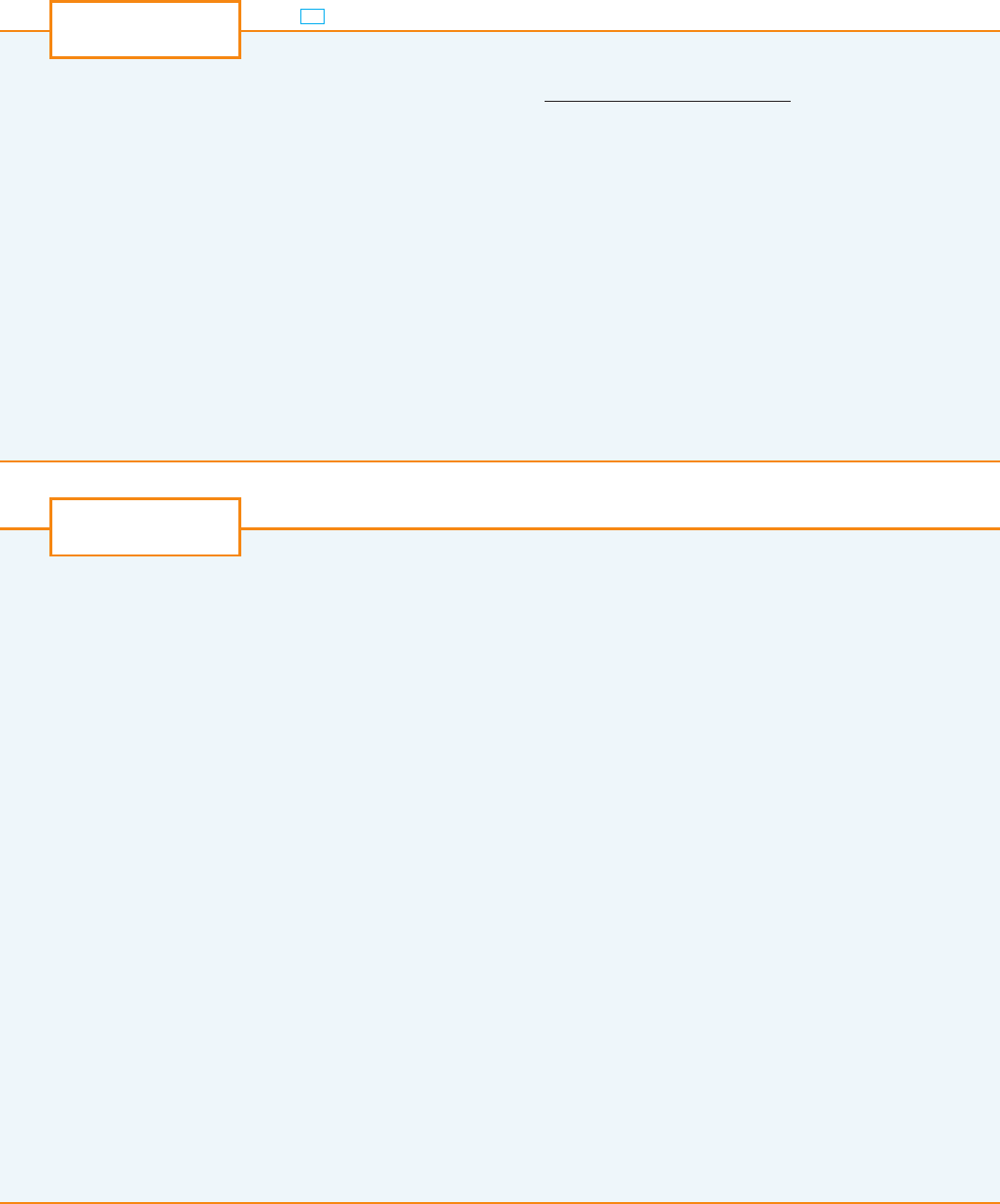
The Binomial Theorem, which gives the expansion of , was known to Chinese mathe-
maticians many centuries before the time of Newton for the case where the exponent k is a
positive integer. In 1665, when he was 22, Newton was the first to discover the infinite series
expansion of when k is a fractional exponent (positive or negative). He didn’t publish
his discovery, but he stated it and gave examples of how to use it in a letter (now called the
epistola prior) dated June 13, 1676, that he sent to Henry Oldenburg, secretary of the Royal
Society of London, to transmit to Leibniz. When Leibniz replied, he asked how Newton had
discovered the binomial series. Newton wrote a second letter, the epistola posterior of Octo-
ber 24, 1676, in which he explained in great detail how he arrived at his discovery by a very
indirect route. He was investigating the areas under the curves from 0 to x for
, 1, 2, 3, 4, . . . . These are easy to calculate if n is even. By observing patterns and inter-
polating, Newton was able to guess the answers for odd values of n. Then he realized he could
get the same answers by expressing as an infinite series.
Write a report on Newton’s discovery of the binomial series. Start by giving the statement of
the binomial series in Newton’s notation (see the epistola prior on page 285 of [4] or page 402
of [2]). Explain why Newton’s version is equivalent to Theorem 17 on page 778. Then read
Newton’s epistola posterior (page 287 in [4] or page 404 in [2]) and explain the patterns that
Newton discovered in the areas under the curves . Show how he was able to
guess the areas under the remaining curves and how he verified his answers. Finally, explain how
these discoveries led to the binomial series. The books by Edwards [1] and Katz [3] contain
commentaries on Newton’s letters.
1. C. H. Edwards, The Historical Development of the Calculus (New York: Springer-Verlag,
1979), pp. 178–187.
2. John Fauvel and Jeremy Gray, eds., The History of Mathematics: A Reader (London:
MacMillan Press, 1987).
3. Victor Katz, A History of Mathematics: An Introduction (New York: HarperCollins, 1993),
pp. 463–466.
4. D. J. Struik, ed., A Sourcebook in Mathematics, 1200–1800 (Princeton, NJ: Princeton
University Press, 1969).
y ! &1 # x
2
'
n,2
&1 # x
2
'
n,2
n ! 0
y ! &1 # x
2
'
n,2
&a ! b'
k
&a ! b'
k
HOW NEWTON DISCOVERED THE BINOMIAL SERIES
W R I T I N G
P R O J E C T
784
|| ||
CHAPTER 12 INFINITE SEQUENCES AND SERIES
This project deals with the function
1. Use your computer algebra system to evaluate for and .
Does it appear that has a limit as ?
2. Use the CAS to graph near . Does it appear that has a limit as ?
3. Try to evaluate with l’Hospital’s Rule, using the CAS to find derivatives of the
numerator and denominator. What do you discover? How many applications of l’Hospital’s
Rule are required?
4. Evaluate by using the CAS to find sufficiently many terms in the Taylor series
of the numerator and denominator. (Use the command
taylor in Maple or Series in
Mathematica.)
5. Use the limit command on your CAS to find directly. (Most computer algebra
systems use the method of Problem 4 to compute limits.)
6.
In view of the answers to Problems 4 and 5, how do you explain the results of Problems 1 and 2?
lim
x
l
0
f &x'
lim
x
l
0
f &x'
lim
x
l
0
f &x'
x l 0fx ! 0f
x l 0f
0.0001x ! 1, 0.1, 0.01, 0.001,f &x'
f &x' !
sin&tan x' # tan&sin x'
arcsin&arctan x' # arctan&arcsin x'
AN ELUSIVE LIMIT
CAS
L A B O R A T O R Y
P R O J E C T
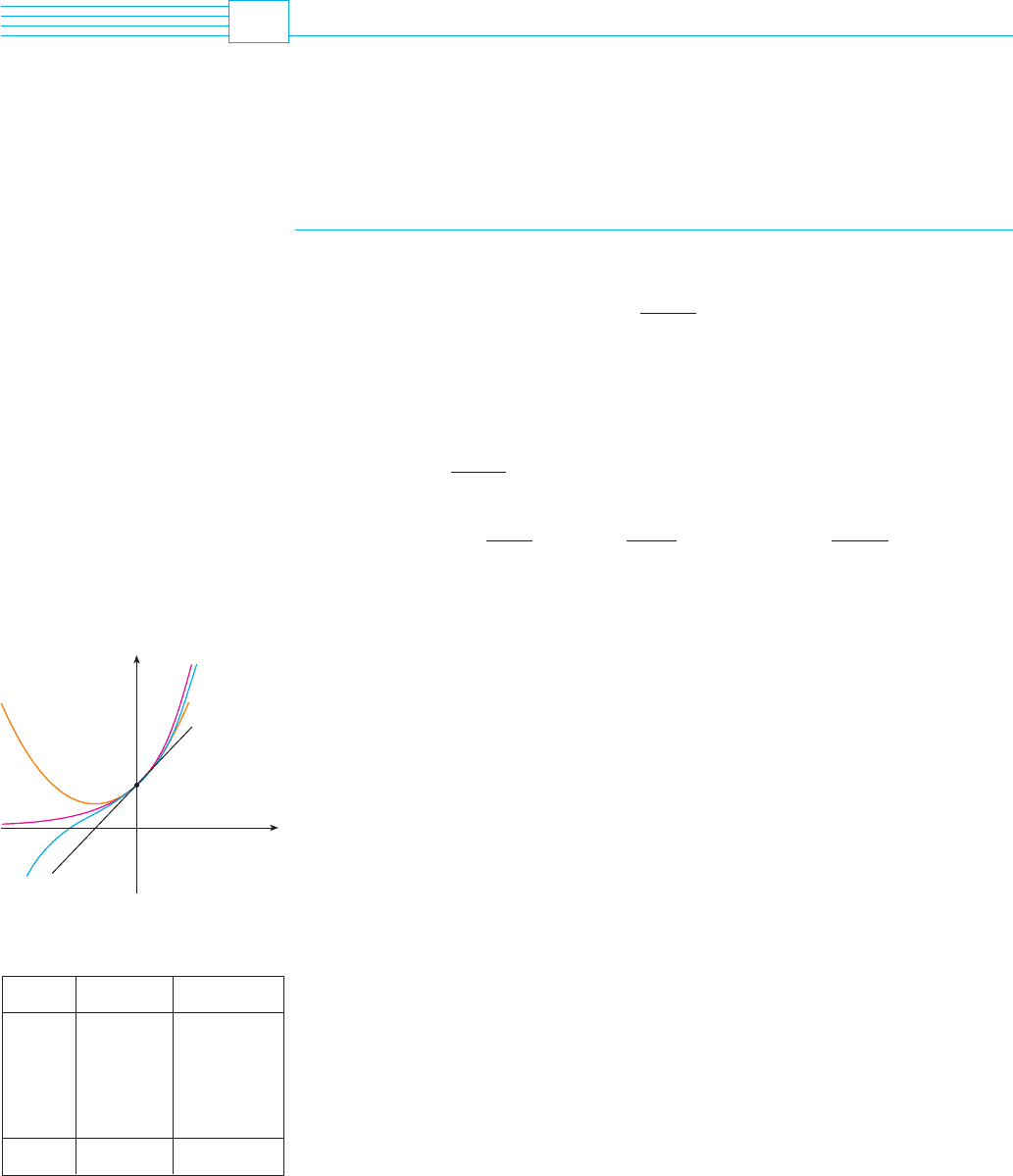
APPLICATIONS OF TAYLOR POLYNOMIALS
In this section we explore two types of applications of Taylor polynomials. First we look
at how they are used to approximate functions––computer scientists like them because
polynomials are the simplest of functions. Then we investigate how physicists and engi-
neers use them in such fields as relativity, optics, blackbody radiation, electric dipoles, the
velocity of water waves, and building highways across a desert.
APPROXIMATING FUNCTIONS BY POLYNOMIALS
Suppose that is equal to the sum of its Taylor series at a:
In Section 12.10 we introduced the notation for the th partial sum of this series
and called it the th-degree Taylor polynomial of at . Thus
Since is the sum of its Taylor series, we know that as and so can
be used as an approximation to : .
Notice that the first-degree Taylor polynomial
is the same as the linearization of f at a that we discussed in Section 3.9. Notice also that
and its derivative have the same values at a that and have. In general, it can be
shown that the derivatives of at agree with those of up to and including derivatives
of order (see Exercise 38).
To illustrate these ideas let’s take another look at the graphs of and its first few
Taylor polynomials, as shown in Figure 1. The graph of is the tangent line to
at ; this tangent line is the best linear approximation to near . The graph
of is the parabola , and the graph of is the cubic curve
, which is a closer fit to the exponential curve than .
The next Taylor polynomial would be an even better approximation, and so on.
The values in the table give a numerical demonstration of the convergence of the Taylor
polynomials to the function . We see that when the convergence is
very rapid, but when it is somewhat slower. In fact, the farther is from 0, the more
slowly converges to .
When using a Taylor polynomial to approximate a function , we have to ask the
questions: How good an approximation is it? How large should we take to be in order to
achieve a desired accuracy? To answer these questions we need to look at the absolute
value of the remainder:
)
R
n
&x'
)
!
)
f &x' # T
n
&x'
)
n
fT
n
e
x
T
n
&x'
xx ! 3
x ! 0.2y ! e
x
T
n
&x'
T
4
T
2
y ! e
x
y ! 1 ! x ! x
2
,2 ! x
3
,6
T
3
y ! 1 ! x ! x
2
,2T
2
&0, 1'e
x
&0, 1'
y ! e
x
T
1
y ! e
x
n
faT
n
f *fT
1
T
1
&x' ! f &a' ! f *&a'&x # a'
f &x' # T
n
&x'f
T
n
n l %T
n
&x' l f &x'f
! f &a' !
f *&a'
1!
&x # a' !
f .&a'
2!
&x # a'
2
! " " " !
f
&n'
&a'
n!
&x # a'
n
T
n
&x' !
(
n
i!0
f
&i'
&a'
i!
&x # a'
i
afn
nT
n
&x'
f &x' !
(
%
n!0
f
&n'
&a'
n!
&x # a'
n
f &x'
12.11
SECTION 12.11 APPLICATIONS OF TAYLOR POLYNOMIALS
|| ||
785
1.220000 8.500000
1.221400 16.375000
1.221403 19.412500
1.221403 20.009152
1.221403 20.079665
1.221403 20.085537e
x
T
10
&x'
T
8
&x'
T
6
&x'
T
4
&x'
T
2
&x'
x ! 3.0x ! 0.2
0
x
y
y=´
y=T£(x)
(0,1)
y=T™(x)
y=T¡(x)
F I G U R E 1

There are three possible methods for estimating the size of the error:
1. If a graphing device is available, we can use it to graph and thereby esti-
mate the error.
2. If the series happens to be an alternating series, we can use the Alternating Series
Estimation Theorem.
3. In all cases we can use Taylor’s Inequality (Theorem 12.10.9), which says that if
, then
EXAMPLE 1
(a) Approximate the function by a Taylor polynomial of degree 2 at .
(b) How accurate is this approximation when ?
SOLUTION
(a)
Thus the second-degree Taylor polynomial is
The desired approximation is
(b) The Taylor series is not alternating when , so we can’t use the Alternating
Series Estimation Theorem in this example. But we can use Taylor’s Inequality with
and :
where . Because , we have and so
Therefore we can take . Also , so and
. Then Taylor’s Inequality gives
Thus, if , the approximation in part (a) is accurate to within .
M
0.00047 + x + 9
)
R
2
&x'
)
+
0.0021
3!
! 1
3
!
0.0021
6
$
0.0004
)
x # 8
)
+ 1
#1 + x # 8 + 17 + x + 9M ! 0.0021
f ,&x' !
10
27
!
1
x
8,3
+
10
27
!
1
7
8,3
$
0.0021
x
8,3
/ 7
8,3
x / 7
)
f ,&x'
)
+ M
)
R
2
&x'
)
+
M
3!
)
x # 8
)
3
a ! 8n ! 2
x
$
8
s
3
x
# T
2
&x' ! 2 !
1
12
&x # 8' #
1
288
&x # 8'
2
! 2 !
1
12
&x # 8' #
1
288
&x # 8'
2
T
2
&x' ! f &8' !
f *&8'
1!
&x # 8' !
f .&8'
2!
&x # 8'
2
f ,&x' !
10
27
x
#8,3
f .&x' ! #
2
9
x
#5,3
f .&8' ! #
1
144
f *&x' !
1
3
x
#2,3
f *&8' !
1
12
f &x' !
s
3
x
! x
1,3
f &8' ! 2
7 + x + 9
a ! 8f &x' !
s
3
x
V
)
R
n
&x'
)
+
M
&n ! 1'!
)
x # a
)
n!1
)
f
&n!1'
&x'
)
+ M
)
R
n
&x'
)
786
|| ||
CHAPTER 12 INFINITE SEQUENCES AND SERIES

Let’s use a graphing device to check the calculation in Example 1. Figure 2 shows that
the graphs of and are very close to each other when is near 8. Fig-
ure 3 shows the graph of computed from the expression
We see from the graph that
when . Thus the error estimate from graphical methods is slightly better than the
error estimate from Taylor’s Inequality in this case.
EXAMPLE 2
(a) What is the maximum error possible in using the approximation
when ? Use this approximation to find correct to six decimal
places.
(b) For what values of is this approximation accurate to within ?
SOLUTION
(a) Notice that the Maclaurin series
is alternating for all nonzero values of , and the successive terms decrease in size
because , so we can use the Alternating Series Estimation Theorem. The error
in approximating by the first three terms of its Maclaurin series is at most
If , then , so the error is smaller than
To find we first convert to radian measure.
Thus, correct to six decimal places, .
(b) The error will be smaller than if
)
x
)
7
5040
$
0.00005
0.00005
sin 12- # 0.207912
#
'
15
#
!
'
15
"
3
1
3!
!
!
'
15
"
5
1
5!
# 0.20791169
sin 12- ! sin
!
12
'
180
"
! sin
!
'
15
"
sin 12-
&0.3'
7
5040
# 4.3 & 10
#8
)
x
)
+ 0.3#0.3 + x + 0.3
/
x
7
7!
/
!
)
x
)
7
5040
sin x
)
x
)
$
1
x
sin x ! x #
x
3
3!
!
x
5
5!
#
x
7
7!
! " " "
0.00005x
sin 12-#0.3 + x + 0.3
sin x # x #
x
3
3!
!
x
5
5!
V
7 + x + 9
)
R
2
&x'
)
$
0.0003
)
R
2
&x'
)
!
)
s
3
x
# T
2
&x'
)
)
R
2
&x'
)
xy ! T
2
&x'y !
s
3
x
SECTION 12.11 APPLICATIONS OF TAYLOR POLYNOMIALS
|| ||
787
2.5
0
15
T™
y=
#
œ
„
x
F I G U R E 2
0.0003
7 9
y=|R™(x)|
0
F I G U R E 3
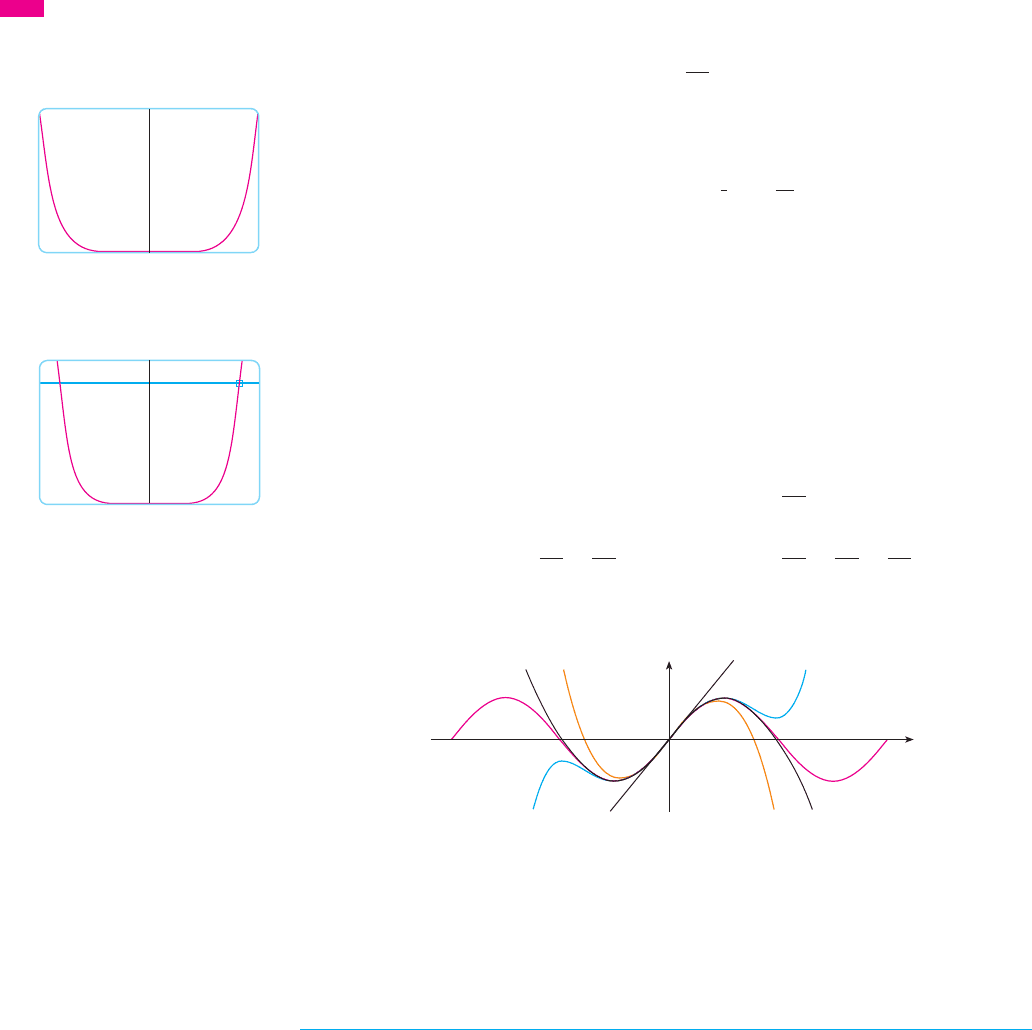
Solving this inequality for , we get
So the given approximation is accurate to within when . M
What if we use Taylor’s Inequality to solve Example 2? Since , we
have and so
So we get the same estimates as with the Alternating Series Estimation Theorem.
What about graphical methods? Figure 4 shows the graph of
and we see from it that when . This is the same estimate
that we obtained in Example 2. For part (b) we want , so we graph both
and in Figure 5. By placing the cursor on the right intersection
point we find that the inequality is satisfied when . Again this is the same esti-
mate that we obtained in the solution to Example 2.
If we had been asked to approximate instead of in Example 2, it would
have been wise to use the Taylor polynomials at (instead of ) because they
are better approximations to for values of close to . Notice that is close to
(or radians) and the derivatives of are easy to compute at .
Figure 6 shows the graphs of the Maclaurin polynomial approximations
to the sine curve. You can see that as increases, is a good approximation to on
a larger and larger interval.
One use of the type of calculation done in Examples 1 and 2 occurs in calculators and
computers. For instance, when you press the or key on your calculator, or when a
computer programmer uses a subroutine for a trigonometric or exponential or Bessel func-
tion, in many machines a polynomial approximation is calculated. The polynomial is often
a Taylor polynomial that has been modified so that the error is spread more evenly through-
out an interval.
APPLICATIONS TO PHYSICS
Taylor polynomials are also used frequently in physics. In order to gain insight into an
equation, a physicist often simplifies a function by considering only the first two or three
terms in its Taylor series. In other words, the physicist uses a Taylor polynomial as an
e
x
sin
F I G U R E 6
0
x
y
T¶
T∞
T£
y=sin x
T¡
sin xT
n
&x'n
T
5
&x' ! x #
x
3
3!
!
x
5
5!
T
7
&x' ! x #
x
3
3!
!
x
5
5!
#
x
7
7!
T
1
&x' ! x T
3
&x' ! x #
x
3
3!
'
,3sin x
'
,360-
72-
'
,3xsin x
a ! 0a !
'
,3
sin 12-sin 72-
)
x
)
$
0.82
y ! 0.00005y !
)
R
6
&x'
)
)
R
6
&x'
)
$
0.00005
)
x
)
+ 0.3
)
R
6
&x'
)
$
4.3 & 10
#8
)
R
6
&x'
)
!
)
sin x #
(
x #
1
6
x
3
!
1
120
x
5
)
)
)
R
6
&x'
)
+
1
7!
)
x
)
7
)
f
&7'
&x'
)
+ 1
f
&7'
&x' ! #cos x
)
x
)
$
0.820.00005
)
x
)
$
&0.252'
1,7
# 0.821or
)
x
)
7
$
0.252
x
788
|| ||
CHAPTER 12 INFINITE SEQUENCES AND SERIES
Module 12.10 /12.11 graphically
shows the remainders in Taylor polynomial
approximations.
TE C
4.3 & 10–*
_0.3 0.3
0
y=|Rß(x)|
F I G U R E 4
0.00006
_1 1
y=|Rß(x)|
0
y=0.00005
F I G U R E 5
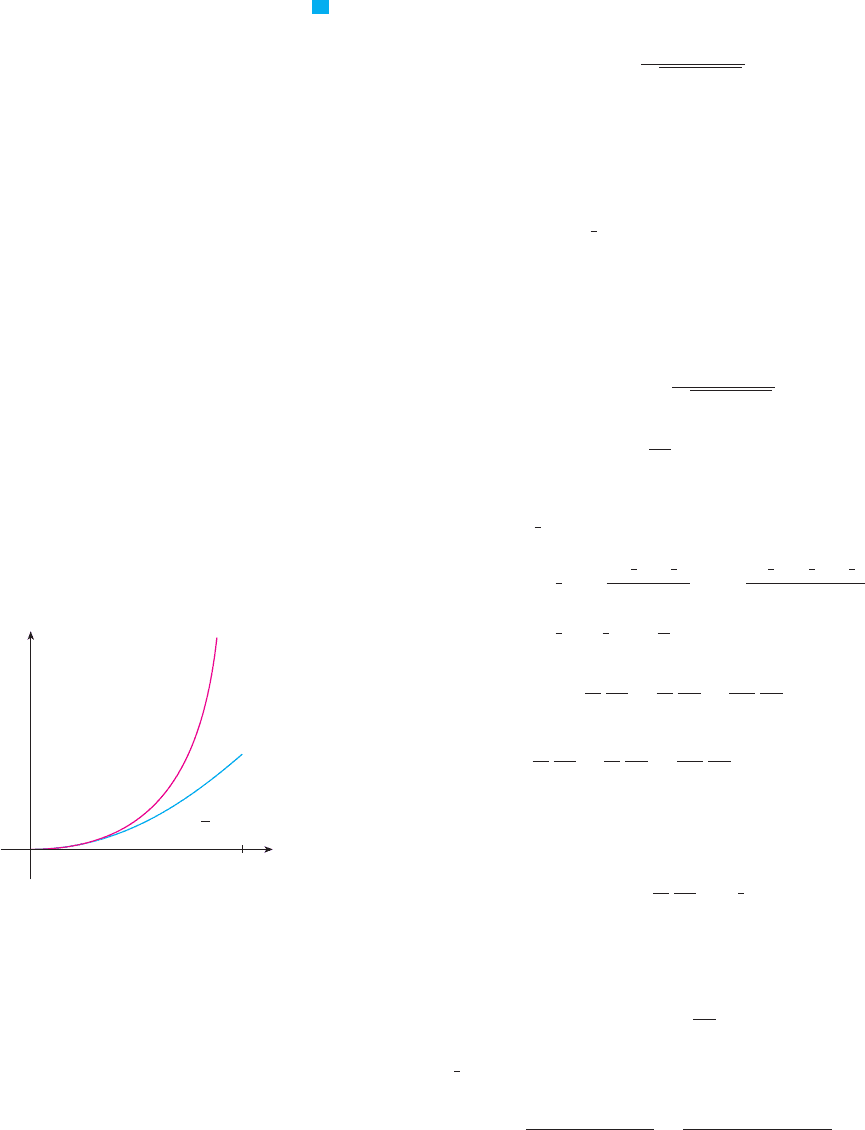
approximation to the function. Taylor’s Inequality can then be used to gauge the accuracy
of the approximation. The following example shows one way in which this idea is used in
special relativity.
EXAMPLE 3 In Einstein’s theory of special relativity the mass of an object moving
with velocity is
where is the mass of the object when at rest and is the speed of light. The kinetic
energy of the object is the difference between its total energy and its energy at rest:
(a) Show that when is very small compared with , this expression for agrees with
classical Newtonian physics: .
(b) Use Taylor’s Inequality to estimate the difference in these expressions for when
m,s.
SOLUTION
(a) Using the expressions given for and , we get
With , the Maclaurin series for is most easily computed as a
binomial series with .
(
Notice that because .
)
Therefore we have
and
If is much smaller than , then all terms after the first are very small when compared
with the first term. If we omit them, we get
(b) If , , and M is a number such that
, then we can use Taylor’s Inequality to write
We have and we are given that m,s, so
)
f .&x'
)
!
3m
0
c
2
4&1 # v
2
,c
2
'
5,2
+
3m
0
c
2
4&1 # 100
2
,c
2
'
5,2
&! M'
)
v
)
+ 100f .&x' !
3
4
m
0
c
2
&1 ! x'
#5,2
)
R
1
&x'
)
+
M
2!
x
2
)
f .&x'
)
+ M
f &x' ! m
0
c
2
-&1 ! x'
#1,2
# 1.x ! #v
2
,c
2
K # m
0
c
2
!
1
2
v
2
c
2
"
!
1
2
m
0
v
2
cv
! m
0
c
2
!
1
2
v
2
c
2
!
3
8
v
4
c
4
!
5
16
v
6
c
6
! " " "
"
K ! m
0
c
2
$!
1 !
1
2
v
2
c
2
!
3
8
v
4
c
4
!
5
16
v
6
c
6
! " " "
"
# 1
%
! 1 #
1
2
x !
3
8
x
2
#
5
16
x
3
! " " "
&1 ! x'
#1,2
! 1 #
1
2
x !
(
#
1
2
)(
#
3
2
)
2!
x
2
!
(
#
1
2
)(
#
3
2
)(
#
5
2
)
3!
x
3
! " " "
v
$
c
)
x
)
$
1k ! #
1
2
&1 ! x'
#1,2
x ! #v
2
,c
2
! m
0
c
2
$!
1 #
v
2
c
2
"
#1,2
# 1
%
K ! mc
2
# m
0
c
2
!
m
0
c
2
s
1 # v
2
,c
2
# m
0
c
2
mK
)
v
)
+ 100
K
K !
1
2
m
0
v
2
Kcv
K ! mc
2
# m
0
c
2
cm
0
m !
m
0
s
1 #
v
2
,c
2
v
V
SECTION 12.11 APPLICATIONS OF TAYLOR POLYNOMIALS
|| ||
789
N The upper curve in Figure 7 is the graph of
the expression for the kinetic energy of an
object with velocity in special relativity. The
lower curve shows the function used for in
classical Newtonian physics. When is much
smaller than the speed of light, the curves are
practically identical.
v
K
v
K
F I G U R E 7
√
K
0
K=mc@-m¸c@
K= m¸√@
1
2
c
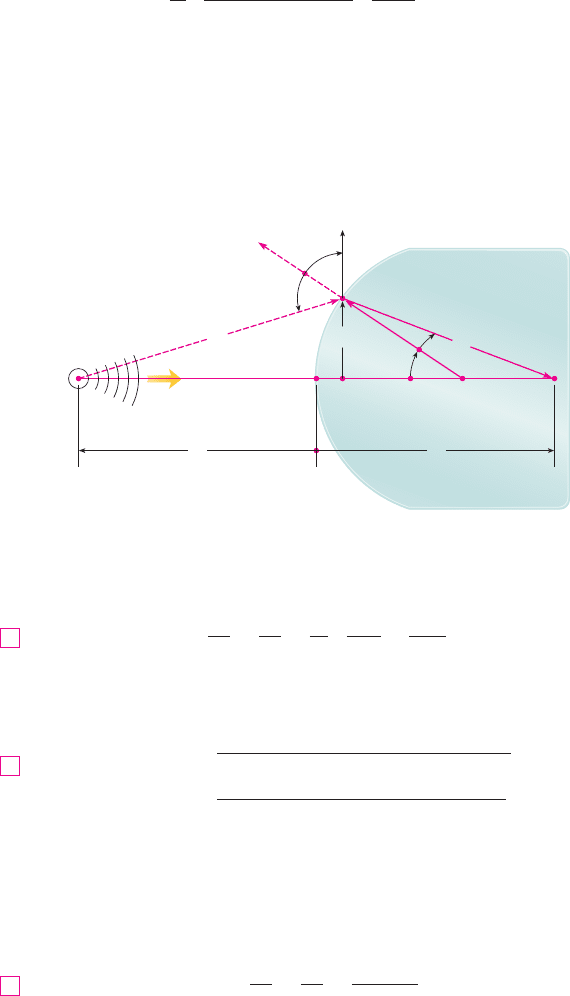
Thus, with ,
So when m!s, the magnitude of the error in using the Newtonian expression
for kinetic energy is at most .
M
Another application to physics occurs in optics. Figure 8 is adapted from Optics,
4th ed., by Eugene Hecht (San Francisco: Addison-Wesley, 2002), page 153. It depicts a
wave from the point source S meeting a spherical interface of radius R centered at C. The
ray SA is refracted toward P.
Using Fermat’s principle that light travels so as to minimize the time taken, Hecht
derives the equation
where and are indexes of refraction and , , , and are the distances indicated in
Figure 8. By the Law of Cosines, applied to triangles ACS and ACP, we have
Because Equation 1 is cumbersome to work with, Gauss, in 1841, simplified it by using
the linear approximation for small values of . (This amounts to using the
Taylor polynomial of degree 1.) Then Equation 1 becomes the following simpler equation
[as you are asked to show in Exercise 34(a)]:
The resulting optical theory is known as Gaussian optics, or first-order optics, and has
become the basic theoretical tool used to design lenses.
A more accurate theory is obtained by approximating by its Taylor polynomial of
degree 3 (which is the same as the Taylor polynomial of degree 2). This takes into account
rays for which is not so small, that is, rays that strike the surface at greater distances h
above the axis. In Exercise 34(b) you are asked to use this approximation to derive the
!
cos
!
n
1
s
o
"
n
2
s
i
!
n
2
# n
1
R
3
!
cos
!
" 1
!
i
!
s
R
2
" #s
i
# R$
2
" 2R#s
i
# R$ cos
!
!
o
!
s
R
2
" #s
o
" R$
2
# 2R#s
o
" R$ cos
!
2
s
i
s
o
!
i
!
o
n
2
n
1
n
1
!
o
"
n
2
!
i
!
1
R
%
n
2
s
i
!
i
#
n
1
s
o
!
o
&
1
A
V
h
C P
R
S
¨
t
¨
r
¨
i
˙
L
o
s
o
s
i
L
i
n¡ n™
Courtesy of Eugene Hecht
F I G U R E 8
Refraction at a spherical interface
#4.2 $ 10
#10
$m
0
'
v
'
% 100
'
R
1
#x$
'
%
1
2
!
3m
0
c
2
4#1 # 100
2
!c
2
$
5!2
!
100
4
c
4
&
#4.17 $ 10
#10
$m
0
c ! 3 $ 10
8
m!s
790
|| ||
CHAPTER 12 INFINITE SEQUENCES AND SERIES
N Here we use the identity
cos#
'
#
!
$ ! #cos
!

more accurate equation
The resulting optical theory is known as third-order optics.
Other applications of Taylor polynomials to physics and engineering are explored in
Exercises 32, 33, 35, 36, and 37 and in the Applied Project on page 793.
n
1
s
o
"
n
2
s
i
!
n
2
# n
1
R
" h
2
(
n
1
2s
o
%
1
s
o
"
1
R
&
2
"
n
2
2s
i
%
1
R
#
1
s
i
&
2
)
4
SECTION 12.11 APPLICATIONS OF TAYLOR POLYNOMIALS
|| ||
791
;
(c) Check your result in part (b) by graphing .
13. , , ,
14. , , ,
15. , , ,
16. , , ,
17. , , ,
, , ,
, , ,
20. , , ,
21. , , ,
22. , , ,
23. Use the information from Exercise 5 to estimate cor-
rect to five decimal places.
24. Use the information from Exercise 16 to estimate
correct to five decimal places.
Use Taylor’s Inequality to determine the number of terms of
the Maclaurin series for that should be used to estimate
to within .
26. How many terms of the Maclaurin series for do you
need to use to estimate to within ?
;
27–29 Use the Alternating Series Estimation Theorem or
Taylor’s Inequality to estimate the range of values of for which
the given approximation is accurate to within the stated error.
Check your answer graphically.
27.
28.
29.
(
'
error
'
&
0.05
)
arctan x " x #
x
3
3
"
x
5
5
(
'
error
'
&
0.005
)
cos x " 1 #
x
2
2
"
x
4
24
(
'
error
'
&
0.01
)
sin x " x #
x
3
6
x
0.001ln 1.4
ln#1 " x$
0.00001
e
0.1
e
x
25.
sin 38(
cos 80(
#1 % x % 1n ! 5a ! 0f #x$ ! sinh 2x
#1 % x % 1n ! 4a ! 0f #x$ ! x sin x
0.5 % x % 1.5n ! 3a ! 1f #x$ ! x ln x
0 % x % 0.1n ! 3a ! 0f #x$ ! e
x
2
19.
0.5 % x % 1.5n ! 3a ! 1f #x$ ! ln#1 " 2x$
18.
#0.2 % x % 0.2n ! 2a ! 0f #x$ ! sec x
0 % x %
'
!3n ! 4a !
'
!6f #x$ ! sin x
0.8 % x % 1.2n ! 3a ! 1f #x$ ! x
2!3
0.9 % x % 1.1n ! 2a ! 1f #x$ ! x
#2
4 % x % 4.2n ! 2a ! 4f #x$ !
s
x
'
R
n
#x$
'
;
1. (a) Find the Taylor polynomials up to degree 6 for
centered at . Graph and these
polynomials on a common screen.
(b) Evaluate and these polynomials at , ,
and .
(c) Comment on how the Taylor polynomials converge
to .
;
2. (a) Find the Taylor polynomials up to degree 3 for
centered at . Graph and these
polynomials on a common screen.
(b) Evaluate and these polynomials at and 1.3.
(c) Comment on how the Taylor polynomials converge
to .
;
3–10 Find the Taylor polynomial for the function at the
number . Graph and on the same screen.
3. ,
4. ,
,
6. ,
7. ,
8. ,
,
10. ,
11–12 Use a computer algebra system to find the Taylor poly-
nomials centered at for . Then graph these
polynomials and on the same screen.
11. ,
12. ,
13–22
(a) Approximate by a Taylor polynomial with degree at the
number .
(b) Use Taylor’s Inequality to estimate the accuracy of the
approximation when x lies in the given
interval.
f #x$ " T
n
#x$
a
nf
a ! 0f #x$ !
s
3
1 " x
2
a !
'
!4f #x$ ! cot x
f
n ! 2, 3, 4, 5aT
n
CAS
a ! 1f #x$ ! tan
#1
x
a ! 0f #x$ ! xe
#2x
9.
a ! 1f #x$ !
ln x
x
a ! 0f #x$ ! arcsin x
a ! 0f #x$ ! e
#x
sin x
a !
'
!2f #x$ ! cos x
5.
a ! 0f #x$ ! x " e
#x
a ! 2f #x$ ! 1!x
T
3
fa
fT
n
#x$
f #x$
x ! 0.9f
fa ! 1f #x$ ! 1!x
f #x$
'
'
!2x !
'
!4f
fa ! 0f #x$ ! cos x
E X E R C I S E S
12.11
